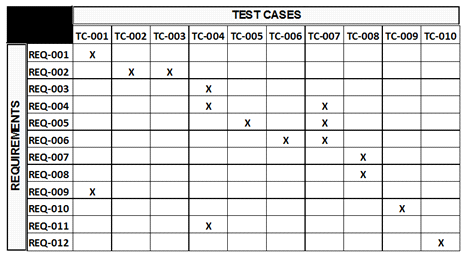BCS ISTQB-BCS Certified Tester Advanced Level- Test Manager TM12 Exam Practice Test
Assume that the following test cases have been executed at the end of the first week of test execution: TC-001, TC-002 and TC-007. All these tests are 'passes'.
What is the MINIMUM number of the remaining test cases that must be successfully executed to fulfill the EX1 exit criteria?

Number of correct responses: 1
Answer : A
Which of the following information would you expect to be the most useful to perform a defect clustering analysis?
Number of correct responses: 1
Answer : B
Consider an information system of a Pay-Tv company based on a SOA architecture.
The integrated system currently consists of three core systems:
- a CRM (Customer Relationship Management) system
- a BRM (Billing and Revenue Management) system
- a CAS (Conditional Access System) system
all of them communicating with SOA Middleware.
You have been asked to manage the testing activities for the integration of two additional off-the-shelf systems from two different vendors: a SMS (Short Message Service) server and an IVR (Interactive Voice Response) system.
Assume that there is a high likelihood that the two off-the-shelf systems will be low-quality and that you have a clear proof that the testing performed by the two vendors on their systems has been unsystematic and unprofessional. This obviously leads to higher quality risk for the overall integrated system.
You are the Test Manager of this project. Your main goal is to plan for testing activities to mitigate this risk.
Which of the following answers best describes the test activities (assuming it is possible to perform all of them) you should plan for?
Number of correct responses: 1
Answer : D
Based on the historical data of 5 past and similar projects, you have calculated these average numbers of defects detected in system testing:
- for each 10000 LOC (lines of code), 200 defects
- for each person-month of development team effort, 49 defects
You want to use this information to perform estimation for a new project.
The project manager tells you that he/she has estimated 20000 new LOC for this new project.
Four developers work for four months on this project before system testing.
During system testing, 797 defects are discovered.
Assume that the system test of this new project is using the same amount of work as spent in the past projects.
Based on this information only, which of the following statement is certainly true about this project?
Number of correct responses: 1
Answer : B
Which of the following is an example of the test closure activity indicated as "lessons learned"?
Number of correct responses: 1
Answer : C
Assume you are a Test Manager involved in system testing of a CRM application for a Pay-TV company. Currently the application is able to support a proper number of users assuring the required responsiveness. Since the business is expected to grow, you have been asked to evaluate the ability of the application to grow to support more users while maintaining the same responsiveness.
Which of the following tools would you expect to be the most useful at performing this evaluation?
Number of correct responses: 1
Answer : D
The following are the requirements identified as ''critical'':
REQ-SEL-001. The user shall be able to combine all the three products with all the four durations to define an item to purchase
REQ-SEL-002. The user shall be able to add a maximum of six different items to the shopping cart
REQ-PUR-001. The user shall be able to purchase all the items in the shopping cart using a credit voucher
REQ-PUR-002. The user shall be able to purchase all the items in the shopping cart using the available credit already charged on the smartcard
REQ-PUR-003. The user shall be able to purchase all the items in the shopping cart using all the accepted credit cards (Visa, MasterCard and Great Wall Card)
REG-LOGO-001. The user shall be able to logout (by clicking the logout button) from both the ''select'' and ''purchase'' pages going back to the ''browse'' page (anonymous navigation)
Moreover the following quality risk item has been identified as ''critical'':
QR-P1. The web customer portal might not be able to provide the expected response time (less than 10 sec) for the purchase transactions under a load of up-to 1000 concurrent users
Test analysis for system testing has just begun and the following test conditions have been identified:
TC-SEL-01. Test the combinations of products and durations to define an item to purchase
TC-SEL-02. Test the maximum number of items, which can be added to the shopping cart
TC-PUR-01. Test the purchase of an item
TC-PUR-02. Test the purchase of an item with the credit charged on the smartcard
What is the MINIMUM number of test conditions that must be added to fulfill both the EXCR1 and EXCR2 exit criteria?
Number of correct responses: 1
Answer : C